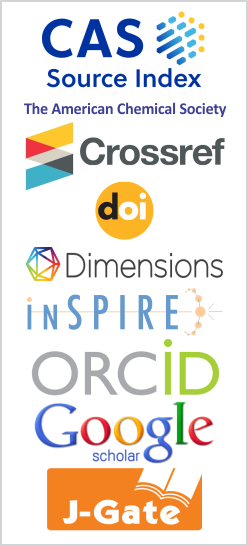First-Principles Modeling of the Smallest Molecular Single Electron Transistor
DOI:
https://doi.org/10.26713/jamcnp.v2i1.270Keywords:
Single electron transistor, Incoherent transport, Ethyne, Coulomb blockade, Quantum tunneling, Charge stability diagramAbstract
Using first-principles method the charging energy has been calculated; of the smallest single electron transistor (SET) consisting of only two carbon atoms while operating in coulumb blockade regime. The ethyne (C2H2) molecule is acting like a quantum dot (with discrete energy levels) and is weakly coupled to the gold electrodes (continuum). The quantum effects are significant and the conduction of current takes place through incoherent method via electron tunneling. The electronic levels of the molecule determine the electron transport properties. The molecule may be in several charged states from +2 to -2. It has been observed that the HOMO-LUMO gap is strongly reduced in solid state environment with metallic electrodes, as compared to the vacuum. This reduction is attributed to the image charges generated in the source and drain electrodes. This results in strong localization of charges in the molecule, a phenomenon addressed earlier. The charging energy has been calculated in vacuum and in SET environment. The interaction between molecule and the electrodes is treated self-consistently through Poisson equation. The charge stability diagram of the smallest molecular SET has been obtained.
Downloads
References
Michel H. Devoret, Robert J. Schoelkopf , Nature 106 (2000).
Schoelkopf, R. L., Moseley, S.H., Stahle C.M., Wahlgreen, P., Delsing P., IEEE Trans App.l Superond 9, (1999).
Komiyama S, Astafiev, O., Antonov, V., Kutsuwa, T, Herai, H., Nature 403 (2000).
Keller, M.W., Eichenberger, A., Martinis A, J.M., Zimmerman, N.M., Science 285 (1999).
Anselmetti, D., Nat. Nanotechnol. 7 (2012).
Xie, P.,Xiong,Q., Fang Y., Qing, Q. Liber, C.M., Nat. Nanotechnol. 7 (2012).
Yan, D.G., Xiao, H.N., Yang, X., J. Phys. Chem. C 116 (2012).
Aviram A., Ratner M, Chem. Phys. Lett. 29 (1974).
Magoga, M., Joachim, C. Phys. Rev. B , 56 (1997).
Emberly, E.G., Kirezenow G., Physical Rev. B 62 (2001).
Lang, N.D. Phys. Rev. B 52 (1992).
Xue, Y., Chem. Phys. 281(2002).
Kubatkin, S., Danilov, A., Hjort, M., Cornil, J. Berdas, J.L., StuhrHansen, N., Hedegard P., Bjornholm, T., Nature 425 (2003).
K Kaasbjerg, K Flensberg Nano. Lett. 8,11(2008).
K Stokbro J. Phys. Chem. C, 114 (2010).
Atomistix ToolKit version 12.2.2, QuantumWise A/S (http://qauntumwise.com).
Handbook of photochemistry, Taylor & Francis group LLC (2006)
Plessis P, Marmet P, Int. J. Mass. Spect. 70 (1986).
Downloads
Published
How to Cite
Issue
Section
License
Authors who publish with this journal agree to the following terms:- Authors retain copyright and grant the journal right of first publication with the work simultaneously licensed under a CCAL that allows others to share the work with an acknowledgement of the work's authorship and initial publication in this journal.
- Authors are able to enter into separate, additional contractual arrangements for the non-exclusive distribution of the journal's published version of the work (e.g., post it to an institutional repository or publish it in a book), with an acknowledgement of its initial publication in this journal.
- Authors are permitted and encouraged to post their work online (e.g., in institutional repositories or on their website) prior to and during the submission process, as it can lead to productive exchanges, as well as earlier and greater citation of published work.




